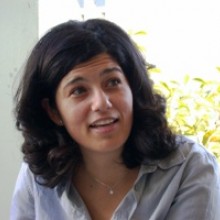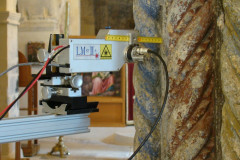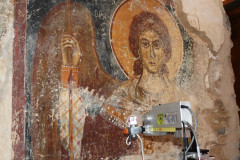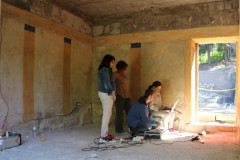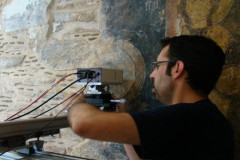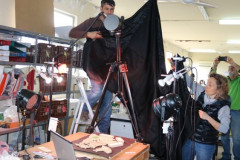TriENA is a hybrid system that combines three spectroscopic analytical techniques (LIBS, LED-IF, and DR) in one portable device. It is a deliverable of the CALLOS project and has been developed at the Institute of Electronic Structure and Laser of FORTH by the Photonics for Heritage Science Researchers, in collaboration with the conservators of EACA. The system is designed to meet the analytical challenges commonly encountered on Athenian monuments.
This hybrid mobile system combines three spectroscopic techniques: Laser-Induced Breakdown Spectroscopy (LIBS), Diffuse Reflectance Spectroscopy (DR), and LED-Induced Fluorescence (LED-IF), leading to an integrated characterization of the material under examination ‘in-situ’ with no sample removal or preparation restrictions. Moreover, the rapid data acquisition and the user-friendly software increase the system's applicability in archaeometry and art conservation.
LIBS offers a qualitative and semi-quantitative multi-elemental analysis, with its main advantage being the ability to perform stratigraphic analysis on a multi-layered object. The process involves focusing a compact Nd:YAG laser (1064 nm, pulse duration = 10 ns) on the object's surface using a lens, generating a micro-plasma. The emission from the micro-plasma is transmitted through a bifurcated optical fiber into a dual spectrometer unit (Avaspec-2048-2-USB2, Avantes) with a spectral range of 200 - 660 nm and a resolution of 0.2 - 0.3 nm. The analytical information is acquired within seconds.
Differential Reflectance (DR) and LED-Induced Fluorescence (LED-IF) provide information about the molecular composition of a material. DR is based on light absorption from the material, while LED-IF relies on fluorescence induced by a LED source. Both techniques are non-destructive, which makes them highly suitable for analyzing objects in cultural heritage and archaeology. A halogen tungsten lamp is used for the DR measurements, while for the LED-IF measurements, a LED source (375, 438, or 632 nm) excites the material. For DR measurements, a halogen tungsten lamp is used, while LED-IF measurements involve exciting the material with a LED source (375, 438, or 632 nm). To capture a wider range of spectra, the signals from DR and LED-IF are recorded using a low-resolution spectrometer (Avaspec-2048L-USB2, Avantes) with a spectral range of 200 - 1100 nm and a resolution of approximately 2.5 nm.
A miniature CCD camera provides a close-up view of the object's surface during analysis, allowing for precise aiming of the laser beam using a cross-hair indicator overlaid on the image. In addition, light sources, along with the required optics and a visualization camera, are integrated into a lightweight and compact optical probe head.





